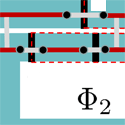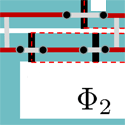A hybrid quantum computer
Like Mac and PC, quantum computers come in two forms, depending on how localized the information is. Researchers are looking into hybrid models that could combine the best of both systems. Two papers in Physical Review Letters describe possible interfaces for relaying information between the two quantum platforms.
Quantum computers store information in “qubits,” which are quantum combinations of ones and zeros. Traditionally, qubits have been recorded in some intrinsic property of an isolated system, like the spin of a trapped electron. The trouble is that any slight interaction with the environment will force the qubit to collapse into a specific state and lose information.
One possible solution to this problem is to use topological quantum computers, which store information in intertwined particle states, called anyons. If one imagines these anyons as checkers on a board, a computation would consist of swapping the pieces in a precise sequence. The quantum information is not localized on individual checkers, but is instead encoded in the way the anyon trajectories weave around each other in spacetime.
Topological qubits have yet to be fully realized, but they show promise as robust quantum storage units. By contrast, conventional qubits appear better suited for a variety of logic gates. To take advantage of both types of “quantum hardware,” Liang Jiang, from Caltech, and his colleagues have proposed a way to link topological qubits on the surface of a topological insulator to conventional qubits made from superconducting wire loops. Parsa Bonderson and Roman Lutchyn at Microsoft Station Q, Santa Barbara, have devised a similar sort of quantum bus to connect anyon-carrying nanowires with conventional quantum dots. – Michael Schirber
Correction (1 April 2011): The affiliation for Parsa Bonderson and Roman Lutchyn was corrected.





